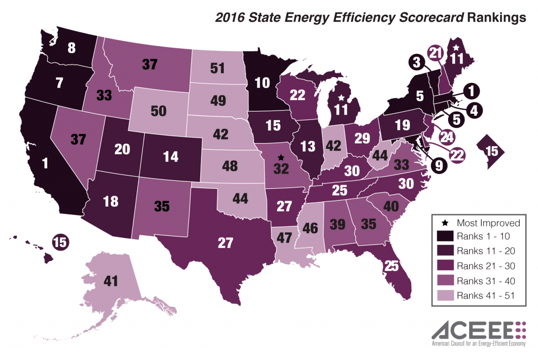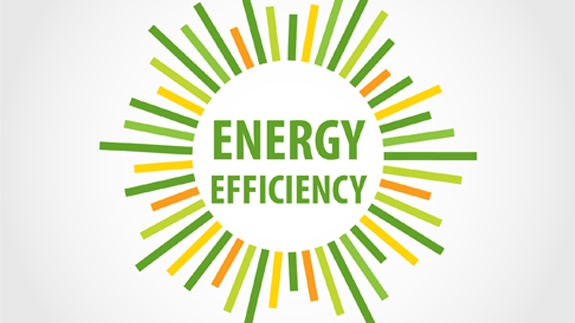
5 Energy Conservation Opportunities for Intelligent Transportation Systems
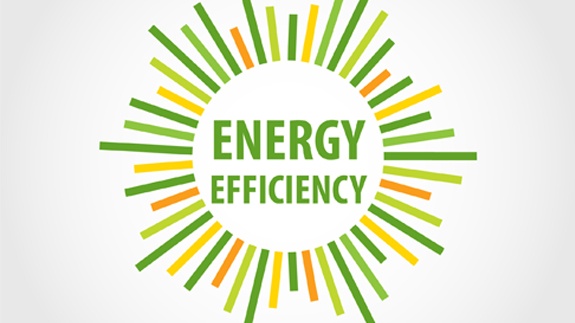 Energy, in whatever form, is a key element all civilizations require in order for its citizens to not only grow, but thrive. Since the 1850's, the world (especially North America) has developed and capitalized on the opportunity of nature’s abundant resources. Over time, new tools for the extraction of assorted resources have been created and the ensuing applications have revolutionized the world’s overall quality of life, emphatically typified in the United States of America.
Energy, in whatever form, is a key element all civilizations require in order for its citizens to not only grow, but thrive. Since the 1850's, the world (especially North America) has developed and capitalized on the opportunity of nature’s abundant resources. Over time, new tools for the extraction of assorted resources have been created and the ensuing applications have revolutionized the world’s overall quality of life, emphatically typified in the United States of America.
From the steam train and the internal combustion engine to the 21st century’s frantic pace, transportation energy is needed to further applications, such as autonomous vehicles, with varying energy sources that are widely available and affordable in North America. With advancing technologies enhancing renewable energy reliability, why the slow up take towards energy efficient design and conservation in the ITS industry?
As ITS systems move towards a more sophisticated future, why aren’t energy efficient design and components further utilized? In this article, we take a look at the five short and long term benefits alternative energy sources provide to the Intelligent Transportation community.
1- Energy Efficiency, Regardless of Source, Conserves Money
 Energy efficient devices consume less power, reducing long term operating costs. Key to this is the proper evaluation of short and long term energy savings after the first cost purchase and over the lifetime of the device. Typically, large scale infrastructure projects not only have first cost and life span considerations, but operating and maintenance projections as part of a viability assessment. ITS devices, as vital infrastructure, requires the same assessments.
Energy efficient devices consume less power, reducing long term operating costs. Key to this is the proper evaluation of short and long term energy savings after the first cost purchase and over the lifetime of the device. Typically, large scale infrastructure projects not only have first cost and life span considerations, but operating and maintenance projections as part of a viability assessment. ITS devices, as vital infrastructure, requires the same assessments.
Appliances and other devices ranked as "Energy Star" certified will reduce electrical bills, as plainly stated on every device. With no such classification in the ITS industry, DOTs and other agencies often pay the power consumption bills without analyzing costs, maintenance budgets, and accounting for the continually rising costs in utilities. Priority assessment for taxpayer interest, towards longer term costs, amount to over one third of total final costs. From a taxpayer perspective, efficiency in operational costs is extremely important, especially if over $0.30 of every $1.00 is not considered in ITS equipment evaluation.
Sample Cost Evaluation: A comparison of power grid costs for SESA Dynamic Message Signs shows a minimum of 30% more energy efficiency than competitive options. Further, 10 large full matrix DMS of 28x125 pixels saves over $200,000 in 10 years compared to industry standard suppliers. This clearly demonstrates huge savings, which could feasibly provide an additional 4-7 new signs!
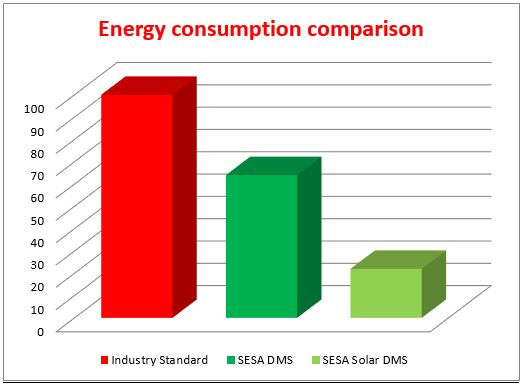
2- Energy Efficient Product Deployment Proven To Cost Less Money & Effort
Energy efficient product are often physically smaller than other options - thus installation is less complex and costly. Importantly, energy efficient products (EEP) use less electrical current, given their voltage needs, which means smaller power cables, simpler installation, and reduced expenses. Electrical feed equipment and similar devices will be adapted to real power consumption, likely with reduced equipment size requirements.
Using less energy, ease of installation occurs given the distance from the energy source and smaller equipment needs. These smaller ITS equipment deployments, in both rural or remote areas, has shown enhanced value in terms of cost and energy availability. In urban areas, it is often difficult to install a new feeding cabinet or power network without even taking into consideration the higher installation costs. EEP’s are capable of utilizing existing power sources, such as street lighting, without additional infrastructure. This is simply not possible in other power hungry, non-efficient devices.
The benefits of energy efficient product deployment is simple; save on size, save on costs. Larger energy consumption devices are not necessarily more expensive than smaller ones, but the overall cost of EEP installation is inherently less. By saving on civil engineering and intricate site work, DOTs benefit from faster field installation and project management deployments.
3- Energy Efficient Products Result in Easier Maintenance
Achieving energy efficiency, each internal component of the EEP optimizes current technology with less dissipation of heat. Without complex heat issues, the EEP component doesn’t require ventilation or other climate control devices. Less devices mean less risk of failure, less spare parts, less maintenance and again, lower operating costs.
SESA achieved energy efficient DMS by creating a virtuous spiral:
Powerful ultra-bright LED’s combined with high contrast front face reduces the number of LEDs required to achieve optimal optical performance in DMS signs. Less LED's translates to the implementation of fewer properly designed power supplies, thus less heat, and with no ventilation system, less money. Through superior design and product utilization, we are able to eliminate or drastically reduces energy necessity. The SESA design principles are applied to all EEP products resulting in greater energy efficiency than the Intelligent Transportation industry average.
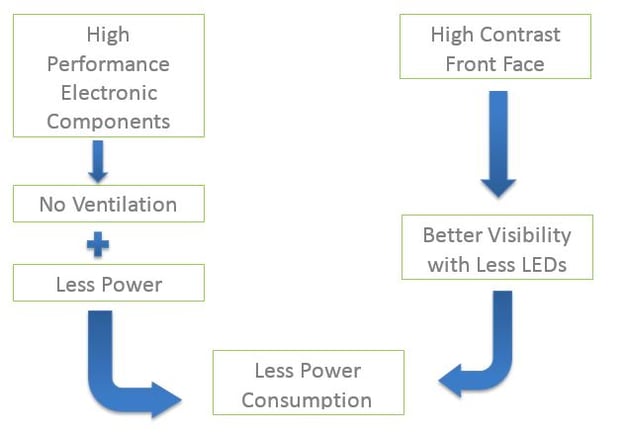
Virtuous Spiral: one engineering innovation leads to another one - ultimately creating a more efficient product.
4- Calculating an Optimized ITS Solar System
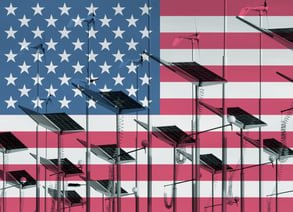 Commonly mistaken and frequently applied by designers or engineers, powering electrically inefficient devices with traditional solar power integration techniques is not a solution. When calculating the solar power system, generalities are often applied to application, size, and surrounding geography, which typically leads to oversized or ill designed systems. Simply understanding energy efficient device capability is the first premise for proper design. More than not, the improper design of integrated solar power systems lead to a more costly and difficult to install system. Poor designs in the recent past have led to a general distrust in all, but the smallest, solar powered systems within the ITS industry today.
Commonly mistaken and frequently applied by designers or engineers, powering electrically inefficient devices with traditional solar power integration techniques is not a solution. When calculating the solar power system, generalities are often applied to application, size, and surrounding geography, which typically leads to oversized or ill designed systems. Simply understanding energy efficient device capability is the first premise for proper design. More than not, the improper design of integrated solar power systems lead to a more costly and difficult to install system. Poor designs in the recent past have led to a general distrust in all, but the smallest, solar powered systems within the ITS industry today.
With multiple differences between ITS devices in the marketplace, it's important to precisely define the need and functionality for practical and robust systems. As ITS examples, cellular modem power needs range from 2-4 watts to 12-15 watts, depending functionality, while CCTV traffic cameras typically range from 20-50 watts.
5- Conserving Energy is a Communal Approach to Planet Preservation
 The ITS-related reasons listed above all apply globally - energy efficiency is simply the right thing to do. Saving energy, even in the most obvious ways, is critically important. We’ve all developed conservation habits domestically in our lives some way. Why have we been so slow in, what one would consider maybe not so aptly named, Intelligent Transportation? In the US, we are rapidly accelerating our dedication to alternative and more efficient electrical power production. Solar and wind power systems are taking hold in every state or community, both public or private in nature. Yet, in the Intelligent Transportation Society a general policy or dedication does not exist, let alone a morale within the community to strive for a better energy efficiency policy (spoken or written). We can do more with less energy and smarter systems- it’s just a matter of education and focus.
The ITS-related reasons listed above all apply globally - energy efficiency is simply the right thing to do. Saving energy, even in the most obvious ways, is critically important. We’ve all developed conservation habits domestically in our lives some way. Why have we been so slow in, what one would consider maybe not so aptly named, Intelligent Transportation? In the US, we are rapidly accelerating our dedication to alternative and more efficient electrical power production. Solar and wind power systems are taking hold in every state or community, both public or private in nature. Yet, in the Intelligent Transportation Society a general policy or dedication does not exist, let alone a morale within the community to strive for a better energy efficiency policy (spoken or written). We can do more with less energy and smarter systems- it’s just a matter of education and focus.
Environmentally, saving electrical energy reduces the global carbon footprint and pollution. As ITS members, the first step professionally is to look to the ITS performance we deploy. Rate the use of ITS systems on contribution to electrical energy reduction and long term costs - no short term need. The practice of cheapest bid offering needs to give way to long term and global performance standards to save money via smart planning.
What’s next?
While the ITS industry is moving in the right direction, there is a pattern of under-utilizing opportunities for energy efficient design, both currently in the market and from an evaluation perspective. We see solar panels everywhere, but they are limited in their use for solar for CCTV cameras, Bluetooth readers, radar, and of course, Dynamic Message Signs. There is a general shortage of education and application standards in the ITS industry, but there is an opportunity to move in the right direction. Energy efficiency is becoming an important evaluation criteria when selecting an ITS device.
